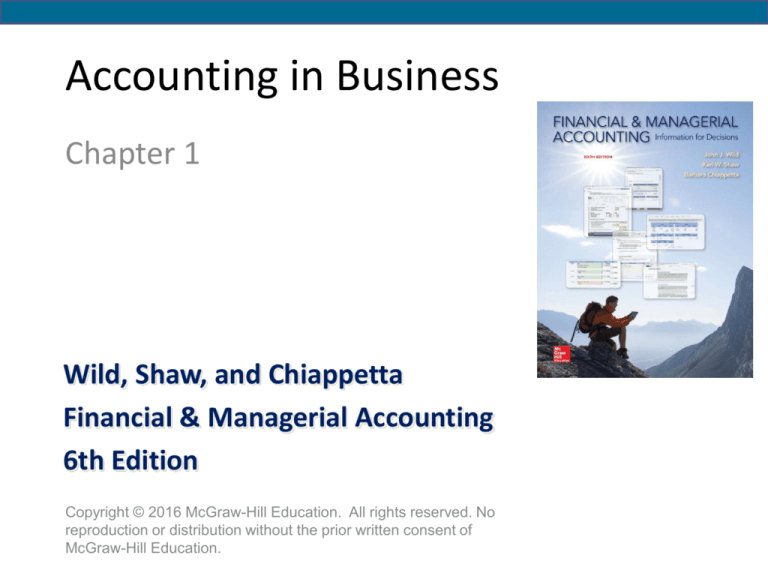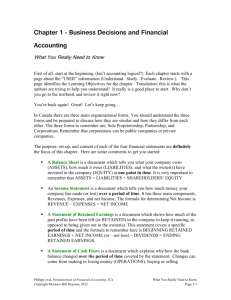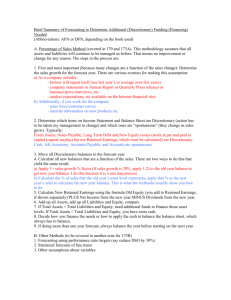
Accounting in Business
Chapter 1
Wild, Shaw, and Chiappetta
Financial & Managerial Accounting
6th Edition
Copyright © 2016 McGraw-Hill Education. All rights reserved. No
reproduction or distribution without the prior written consent of
McGraw-Hill Education.
01-C1:
Explain the Purpose and
Importance of Accounting.
2
1-3
Importance of Accounting
For example, the sale
by Apple of an iPhone.
C1
Keep a chronological
log of transactions.
Prepare reports such as
financial statements.
3
1-4
Users of Financial Information
Accounting is called the language of business because all organizations
set up an accounting information system to communicate data to help
people make better decisions. Accounting serves many users who can be
divided into two groups: external users and internal users.
C2
4
1-5
Opportunities in Accounting
Accounting information is in all aspects of our lives. When
we earn money, pay taxes, invest savings, budget
earnings, and plan for the future, we use accounting.
C2
5
NEED-TO-KNOW 1-1
Identify the following users of accounting information as either an (a) external or (b) internal user.
Regulator
CEO
Shareholder
Controller
Executive Employee
External Auditor
Production Manager
Nonexecutive Employee
a)
b)
a)
b)
b)
a)
b)
a)
External user
Internal user
External user
Internal user
Internal user
External user
Internal user
External user
External users of accounting information are NOT directly involved in running the organization.
Internal users of accounting information ARE directly involved in managing and operating an organization.
6
1-7
Ethics – A Key Concept
The goal of accounting is to provide useful information for
decisions. For information to be useful, it must be trusted.
This demands ethics in accounting. Ethics are beliefs that
distinguish right from wrong. They are accepted standards of
good and bad behavior.
C3
7
1-8
Fraud Triangle
Three factors must exist for a person to commit fraud:
opportunity, pressure, and rationalization.
Envision a way to commit
fraud with a low perceived
risk of getting caught
C3
Fails to see the criminal
nature of the fraud or
justifies the action
Must have some pressure to
commit fraud, like unpaid bills
8
1-9
Generally Accepted
Accounting Principles (GAAP)
Financial accounting is governed by concepts and rules known
as generally accepted accounting principles (GAAP). GAAP aims
to make information relevant, reliable, and comparable.
Reliable information is
trusted by users.
Relevant information
affects decisions
of users.
C4
Comparable information
is helpful in contrasting
organizations.
9
1 - 10
International Standards
In today’s global economy, there is increased demand by external
users for comparability in accounting reports. This demand often
arises when companies wish to raise money from lenders and
investors in different countries.
International Accounting
Standards Board (IASB)
International Financial
Reporting Standards (IFRS)
An independent group
(consisting of individuals
from many countries), issues
International Financial
Reporting Standards (IFRS)
Identify preferred accounting
practices
Differences between U.S. GAAP and IFRS are decreasing as the
FASB and IASB pursue a convergence process aimed to achieve a
single set of accounting standards for global use.
C4
10
1 - 11
Conceptual Framework and
Convergence
C4
11
1 - 12
Principles and Assumptions of Accounting
General principles are the basic
assumptions, concepts, and
guidelines for preparing financial
statements. General principles stem
from long-used accounting practices.
C4
Specific principles are detailed rules
used in reporting business
transactions and events. Specific
principles arise more often from the
rulings of authoritative groups.
12
1 - 13
Accounting Principles
Measurement Principle
(or Cost Principle)
Accounting information is based
on actual cost. Actual cost is
considered objective.
Expense Recognition Principle
(or Matching Principle)
A company must record its expenses
incurred to generate the revenue
reported.
C4
Revenue Recognition Principle
1. Recognize revenue when it is
earned.
2. Proceeds need not be in cash.
3. Measure revenue by cash received
plus cash value of items received.
Full Disclosure Principle
A company is required to report the
details behind financial statements that
would impact users’ decisions.
13
1 - 14
Accounting Assumptions
Going-Concern Assumption
Reflects assumption that the
business will continue operating
instead of being closed or sold.
Monetary Unit Assumption
Express transactions and events
in monetary, or money, units.
Business Entity Assumption
Time Period Assumption
Presumes that the life of a company
can be divided into time periods,
such as months and years.
C4
A business is accounted for
separately from other business
entities, including its owner.
14
1 - 15
Proprietorship, Partnership,
and Corporation
A business entity can take one of three legal forms:
proprietorship, partnership, or corporation
Here are some of the major attributes of proprietorships, partnerships,
and corporations:
C4
15
1 - 16
Sarbanes–Oxley (SOX)
Congress passed the Sarbanes–Oxley Act to help curb financial abuses at
companies that issue their stock to the public. SOX requires that these public
companies apply both accounting oversight and stringent internal controls.
The desired results include more transparency, accountability, and
truthfulness in reporting transactions.
Here are
some recent
accounting
scandals.
C4
16
1 - 17
Dodd-Frank Wall Street Reform and
Consumer Protection Act
This act was designed to:
1. promote accountability and transparency in the
financial system,
2. put an end to the notion of “too big to fail,”
3. protect the taxpayer by ending bailouts, and
4. protect consumers from abusive financial services.
C4
17
NEED-TO-KNOW Part 1:
Principles: Govern the amount and/or timing of information to be reported in financial statements.
C3/C4
Measurement principle
Also called the cost principle
Cost is measured on a cash or equal-to-cash basis.
Governs valuation of assets and liabilities on the balance sheet.
Revenue recognition principle
Governs the timing of revenues recognized on the income
statement.
Revenue is recognized when earned.
Expense recognition principle
Also called the matching principle
Governs the timing of expenses reported on the income
statement.
Expenses are recognized in the same time period as the
revenues they help generate.
Full disclosure principle
A company must report the details behind financial statements
that would impact users' decisions.
Disclosures are often in the footnotes to the financial
statements.
18
NEED-TO-KNOW Part 1:
Assumptions: Generally related to the financial statement headings.
Going concern assumption
Monetary unit assumption
Time period assumption
Business entity assumption
Presumption that the business will continue operating instead of
being closed or sold.
We can express transactions and events in monetary units.
(i.e., Dollars, Pesos, Euros)
Presumes that the life of a company can be divided into time
periods, and that useful reports can be prepared for those
periods.
A business is accounted for separately from other business
entities, including its owner(s).
Accounting constraints: Reasonableness of information to be reported.
C3/C4
Materiality
Only information that would influence the decisions of a
reasonable person needs to be disclosed.
Materiality is a function of the nature of the item and/or dollar amount.
Benefits exceed cost
The benefits of the information disclosed must be greater than
the costs of providing the information.
19
1 - 20
Transaction Analysis and the Accounting
Equation
The Accounting Equation
Assets
=
Liabilities
+
Equity
Expanded Accounting Equation:
Equity
Assets = Liabilities + Contributed Capital
+
Retained Earnings
= Liabilities + Common Stock - Dividends + Revenues - Expenses
A1
Net Income
20
1 - 21
NEED-TO-KNOW (1-3)
Use the accounting equation to compute the missing financial statement amounts.
Bose
Vogue
Assets = Liabilities + Equity
$150 =
$30 + $120
$400 =
$100 + $300
Use the expanded accounting equation to compute the missing financial statement amounts.
Assets = Liabilities + Equity
Nikon
YouTube
$200
$400
$80
$160
$120
$240
+Common - Dividends + Revenues - Expenses
Stock
$100
$0
$60
($40)
$220
($10)
$120
($90)
21
Transaction Analysis
Chas Taylor invests $30,000 cash to
start a company.
The accounts involved are:
(1) Cash (asset)
(2) Common Stock (equity)
P1
Let’s use the Accounting Equation:
Chas Taylor invests $30,000 cash to start
the business, Fast Forward.
Assets
Cash
(1) $ 30,000
$ 30,000
P1
Supplies Equipment
Liabilities
Accounts
Notes
Payable
Payable
$
$
-
$ 30,000
=
$
=
-
$
-
$ 30,000
+
Equity
Common
Stock
$ 30,000
$ 30,000
Transaction Analysis
Company purchased supplies paying
$2,500 cash. . .
Assets
=
Cash
Supplies Equipment
(1) $ 30,000
(2)
(2,500) $ 2,500
$ 27,500 $ 2,500 $
P1
$ 30,000
Liabilities
Accounts
Notes
Payable Payable
+
Equity
Common
Stock
$ 30,000
Accounting Equation
must remain in
balance!!
-
$
=
-
$
-
$ 30,000
$ 30,000
Using the Accounting Equation:
Purchased equipment for $26,000 cash.
Assets
=
Cash
Supplies Equipment
(1) $ 30,000
(2)
(2,500) $ 2,500
(3) (26,000)
$ 26,000
$ 1,500
$ 2,500
$ 30,000
P1
Liabilities
Accounts
Notes
Payable Payable
+
Equity
Common
Stock
$ 30,000
Accounting Equation
still remains in
balance!!
$ 26,000
$
=
-
$
-
$ 30,000
$ 30,000
Using the Accounting Equation
Purchased Supplies of $7,100 on account.
Assets
=
Cash
Supplies Equipment
(1) $ 30,000
(2)
(2,500) $ 2,500
(3) (26,000)
$ 26,000
(4)
7,100
$ 1,500
$ 9,600
$ 37,100
P1
Liabilities
Accounts
Notes
Payable
Payable
+
Equity
Common
Stock
$ 30,000
Accounting Equation still
remains in balance!!
$ 26,000
=
$
7,100
$
7,100
$
-
$ 37,100
$ 30,000
Transaction Analysis
Provided consulting services to a customer
and received $4,200 cash right away.
Assets
=
Cash
Supplies Equipment
Bal. $ 1,500 $ 9,600 $ 26,000
(5)
4,200
$ 5,700 $ 9,600 $ 26,000
$ 41,300
P1
=
Liabilities
+
Equity
Accounts Notes
Payable Payable
$ 7,100
Common
Stock
Revenue
$ 30,000
$ 4,200
$ 7,100 $
$ 30,000 $ 4,200
-
$ 41,300
Transaction Analysis
Paid rent of $1,000 and
salaries of $700 to employees.
Assets
=
Cash
Supplies Equipment
Bal. $ 5,700 $ 9,600 $ 26,000
(6)
(1,000)
(7)
(700)
$ 4,000 $ 9,600 $ 26,000
$ 39,600
P1
=
Liabilities
+
Equity
Accounts Notes
Payable Payable
$ 7,100
Common
Stock
Revenue Expenses
$ 30,000 $ 4,200
(1,000)
$
(700)
$ 7,100 $
$ 30,000 $ 4,200 $ (1,700)
-
$ 39,600
Remember that expenses decrease equity.
Transaction Analysis
Dividends of $200 are paid to shareholders.
Assets
=
Cash
Supplies Equipment
Bal. $ 5,700 $ 9,600 $ 26,000
(6)
(1,000)
(7)
(700)
(8)
(200)
$ 3,800 $ 9,600 $ 26,000
$ 39,400
=
Liabilities
+
Equity
Accounts Notes
Payable Payable
$ 7,100
Common
Stock
$ 30,000
$ 7,100 $
$
$ 30,000 $
$
-
Dividends
Revenue Expenses
$ 4,200
$ 3,000 $ (1,000)
$
(700)
(200)
(200) $ 7,200 $ (1,700)
39,400
Remember that dividends decrease equity.
P1
1 - 30
Financial Statements
The four financial statements and their purposes are:
1. Income statement — describes a company’s revenues and
expenses along with the resulting net income or loss over a
period of time due to earnings activities.
2. Statement of retained earnings— explains changes in
equity from net income (or loss) and from any dividends over
a period of time.
3. Balance sheet — describes a company’s financial position
(types and amounts of assets, liabilities, and equity) at a point
in time.
4. Statement of cash flows — identifies cash inflows (receipts)
and cash outflows (payments) over a period of time.
P2
30
1 - 31
NEED-TO-KNOW (1-5)
Prepare the (a) income statement, (b) statement of retained earnings, and (c) balance sheet, for Apple using the following
condensed data from its fiscal year ended September 28, 20X3.
Accounts payable
Other liabilities
Cost of sales (expense)
Cash
Retained Earnings, Sept. 29, 20X2
Dividends in fiscal year 20X3
Revenues
$22,367
61,084
119,724
14,259
101,289
34,070
170,910
Income Statement
Assets
Liabilities
Equity:
+ Common stock
- Dividends
+ Revenues
- Expenses
Detail of Revenues
Detail of Expenses
Net income (loss)
Investments and other assets
Land and equipment
Selling and other expense
Accounts receivable
Net income
Retained Earnings, Sept. 28, 20X3
Common stock
Statement of Retained Earnings
Beginning Retained Earnings
± Net income (loss)
- Dividends
$163,042
16,597
14,149
13,102
37,037
104,256
19,293
Balance Sheet
Detail of Assets
Detail of Liabilities
Common stock
+ Ending Retained Earnings
Ending Retained Earnings
31
NEED-TO-KNOW
Accounts payable
Other liabilities
Cost of sales (expense)
Cash
Retained Earnings, Sept. 29, 20X2
Dividends in fiscal year 20X3
Revenues
$22,367
61,084
119,724
14,259
101,289
34,070
170,910
APPLE
Income Statement
For Fiscal Year Ended September 28, 20X3
Revenues
$170,910
Expenses
Cost of sales (expense)
$119,724
Selling and other expense
14,149
Total expenses
133,873
Net income
$37,037
1 - 32
Investments and other assets
Land and equipment
Selling and other expense
Accounts receivable
Net income
Retained Earnings, Sept. 28, 20X3
Common stock
$163,042
16,597
14,149
13,102
37,037
104,256
19,293
APPLE
Statement of Retained Earnings
For Fiscal Year Ended September 28, 20X3
Retained Earnings, Sept. 29, 20X2
$101,289
Plus: Net income
37,037
Less: Dividends
(34,070)
Retained Earnings, Sept. 28, 20X3
$104,256
APPLE
Balance Sheet
September 28, 20X3
Assets
Cash
Accounts receivable
Land and equipment
Investments and other assets
Liabilities
$14,259
13,102
16,597
163,042
Accounts payable
Other liabilities
Total liabilities
$22,367
61,084
83,451
Equity
Common Stock
Retained earnings
Total equity
Total assets
$207,000
Total liabilities and equity
19,293
104,256
123,549
$207,000
32
1 - 33
Global View
Basic Principles of U.S. GAAP and IFRS
Both include broad and similar guidance for accounting.
Neither specifies particular account names nor the detail
required.
IFRS does require reporting of certain minimum line and
other minimum disclosures that U.S. GAAP does not.
GAAP requires disclosures for the current and prior two
years for the income statement, statement of cash flows,
and statement of retained earnings (equity)
IFRS requires disclosures for the current and prior year.
33
1 - 34
Global View
Transaction Analysis of U.S. GAAP and IFRS
Both apply transaction analysis identically (as shown in this
chapter). Although some variations exist in revenue and expense
recognition and other principles, all of the transactions in this
chapter are accounted for identically under these two systems.
U.S. GAAP is sometimes considered more “rules-based” whereas
IFRS is more principles-based, particularly in deciding how to
account for certain transactions.
U.S. GAAP—more focused on strictly following the accounting
rules.
IFRS—more focused on a review of the situation and how
accounting can best reflect it.
34
1 - 35
Global View
Financial Statements
Both U.S. GAAP and IFRS prepare the same four basic financial
statements. To illustrate, a condensed version of Samsung’s
income statement follows (numbers are in thousands of U.S.
dollars).
35
1 - 36
Global View
Status of IFRS Adoption
36
1 - 37
Return on Assets
Return on assets (ROA) is stated in ratio form as net
income divided by the average total assets invested.
Return on assets =
A2
Net income
Average total assets
37
1 - 38
Appendix 1A
Return and Risk Analysis
Many different
returns may be
reported.
Risk is the uncertainty
about the return we will
earn.
The lower the risk, the lower our expected return.
ROA
Interest return on
savings accounts.
Interest return on
corporate bonds.
A3
38
1 - 39
Appendix 1B
Business Activities and the Accounting Equation
Three major types of business activities:
Financing activities provide the means organizations use to pay
for resources such as land, buildings, and equipment to carry
out plans.
Owner financing—resources contributed by the owner
along with any income the owner leaves in the organization.
Nonowner financing—resources contributed by creditors
(lenders).
Financial management —the task of planning how to obtain
these resources and to set the right mix between owner and
creditor financing.
C5
39
1 - 40
Appendix 1B
Business Activities and the Accounting Equation
Three major types of business activities:
Investing activities are the acquiring and disposing of resources
(assets) that an organization uses to acquire and sell its
products or services.
Asset management—determining the amount and type of
assets for operations.
Assets—invested amounts.
Liabilities—creditors’ claims.
Equity—owner’s claim.
C5
40
1 - 41
Appendix 1B
Business Activities and the Accounting Equation
Three major types of business activities:
Operating activities involve using resources to research,
develop, purchase, produce, distribute, and market products
and services.
Strategic management —the process of determining the right
mix of operating activities for the type of organization, its
plans, and its market.
C5
41
1 - 42
Appendix 1B
Business Activities and the Accounting Equation
C5
42









